transmission oil NISSAN NV PASSENGER VAN 2018 Owners Manual
[x] Cancel search | Manufacturer: NISSAN, Model Year: 2018, Model line: NV PASSENGER VAN, Model: NISSAN NV PASSENGER VAN 2018Pages: 426, PDF Size: 4.52 MB
Page 19 of 426
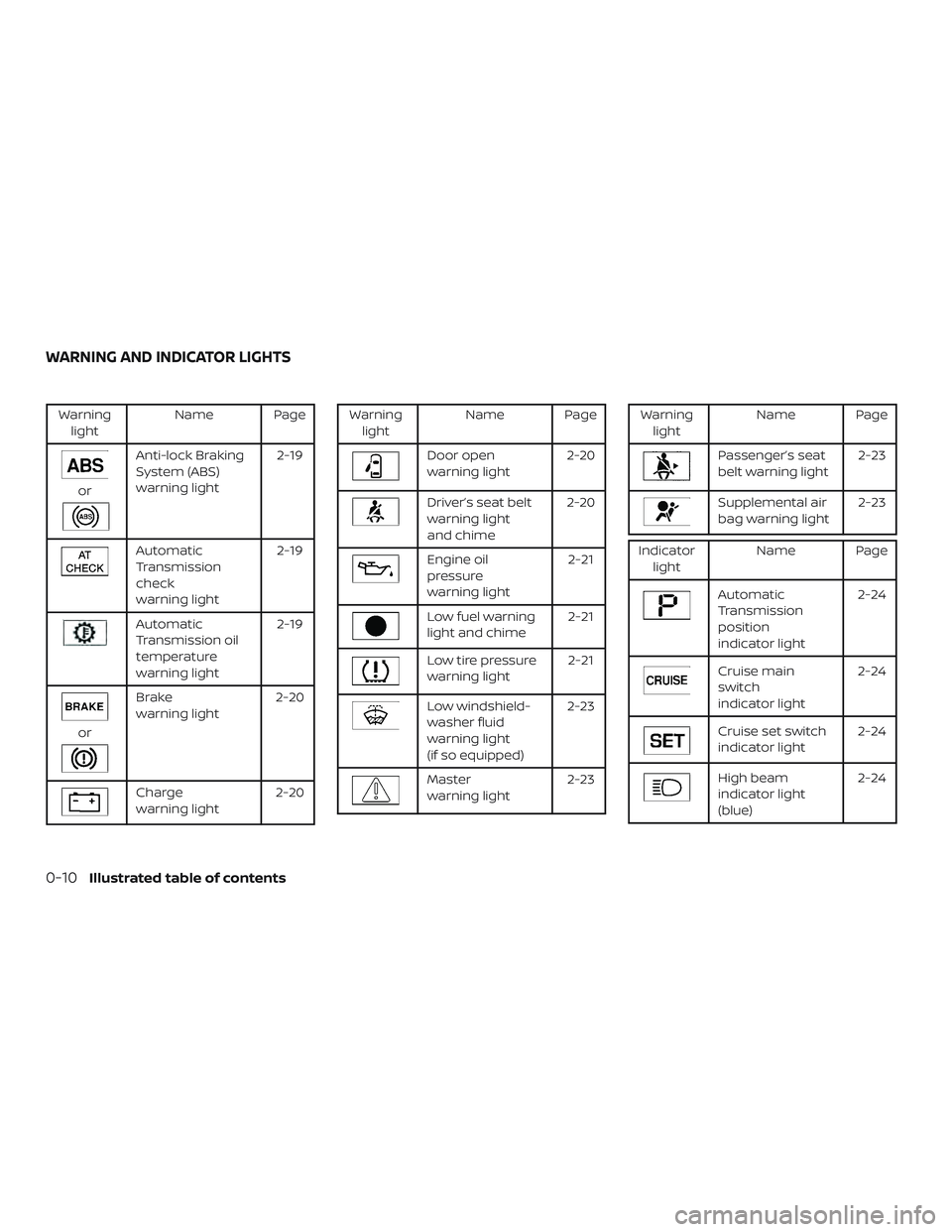
Warninglight Name Page
or
Anti-lock Braking
System (ABS)
warning light 2-19
Automatic
Transmission
check
warning light2-19
Automatic
Transmission oil
temperature
warning light2-19
or
Brake
warning light
2-20
Charge
warning light2-20
Warning
light Name Page
Door open
warning light 2-20
Driver’s seat belt
warning light
and chime2-20
Engine oil
pressure
warning light 2-21
Low fuel warning
light and chime
2-21
Low tire pressure
warning light2-21
Low windshield-
washer fluid
warning light
(if so equipped)2-23
Master
warning light
2-23
Warning
light Name Page
Passenger’s seat
belt warning light 2-23
Supplemental air
bag warning light2-23
Indicator
light Name Page
Automatic
Transmission
position
indicator light 2-24
Cruise main
switch
indicator light
2-24
Cruise set switch
indicator light
2-24
High beam
indicator light
(blue)2-24
WARNING AND INDICATOR LIGHTS
0-10Illustrated table of contents
Page 89 of 426
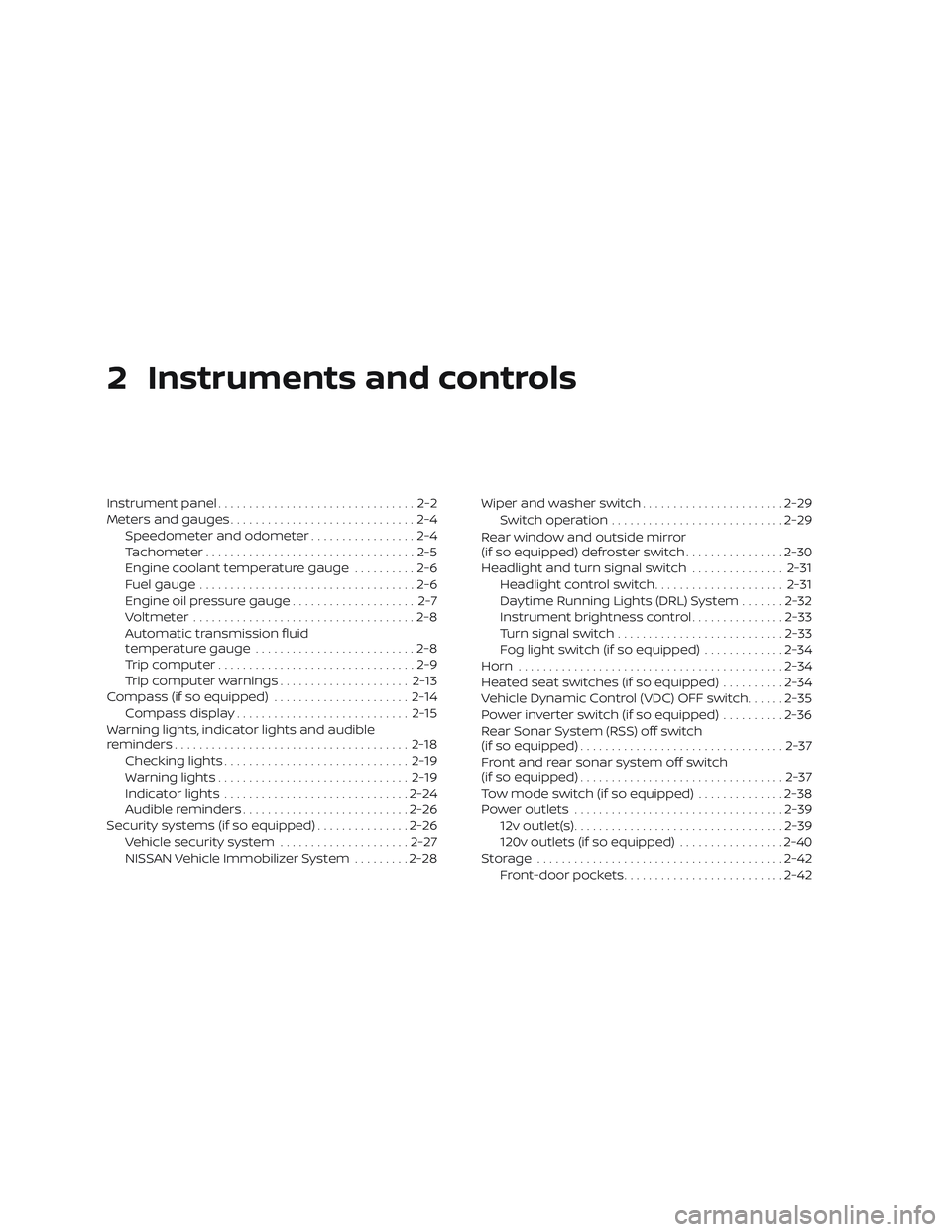
2 Instruments and controls
Instrument panel................................2-2
Meters and gauges ..............................2-4
Speedometer and odometer .................2-4
Tachometer ..................................2-5
Engine coolant temperature gauge ..........2-6
Fuel gauge ...................................2-6
Engine oil pressure gauge .................... 2-7
Voltmeter ....................................2-8
Automatic transmission fluid
temperature gauge ..........................2-8
Trip computer ................................2-9
Trip computer warnings .....................2-13
Compass (if so equipped) ......................2-14
Compass display ............................ 2-15
Warning lights, indicator lights and audible
reminders ...................................... 2-18
Checking lights .............................. 2-19
Warning lights ............................... 2-19
Indicator lights .............................. 2-24
Audible reminders ........................... 2-26
Security systems (if so equipped) ...............2-26
Vehicle security system .....................2-27
NISSAN Vehicle Immobilizer System .........2-28 Wiper and washer switch
.......................2-29
Switch operation ............................ 2-29
Rear window and outside mirror
(if so equipped) defroster switch ................2-30
Headlight and turn signal switch ...............2-31
Headlight control switch .....................2-31
Daytime Running Lights (DRL) System .......2-32
Instrument brightness control ...............2-33
Turn signal switch ........................... 2-33
Fog light switch (if so equipped) .............2-34
Horn ........................................... 2-34
Heated seat switches (if so equipped) ..........2-34
Vehicle Dynamic Control (VDC) OFF switch ......2-35
Power inverter switch (if so equipped) ..........2-36
Rear Sonar System (RSS) off switch
(if so equipped) ................................. 2-37
Front and rear sonar system off switch
(if so equipped) ................................. 2-37
T
ow mode switch (if so equipped) ..............2-38
Power outlets .................................. 2-39
12v outlet(s) .................................. 2-39
120v outlets (if so equipped) .................2-40
Storage ........................................ 2-42
Front-door pockets .......................... 2-42
Page 103 of 426
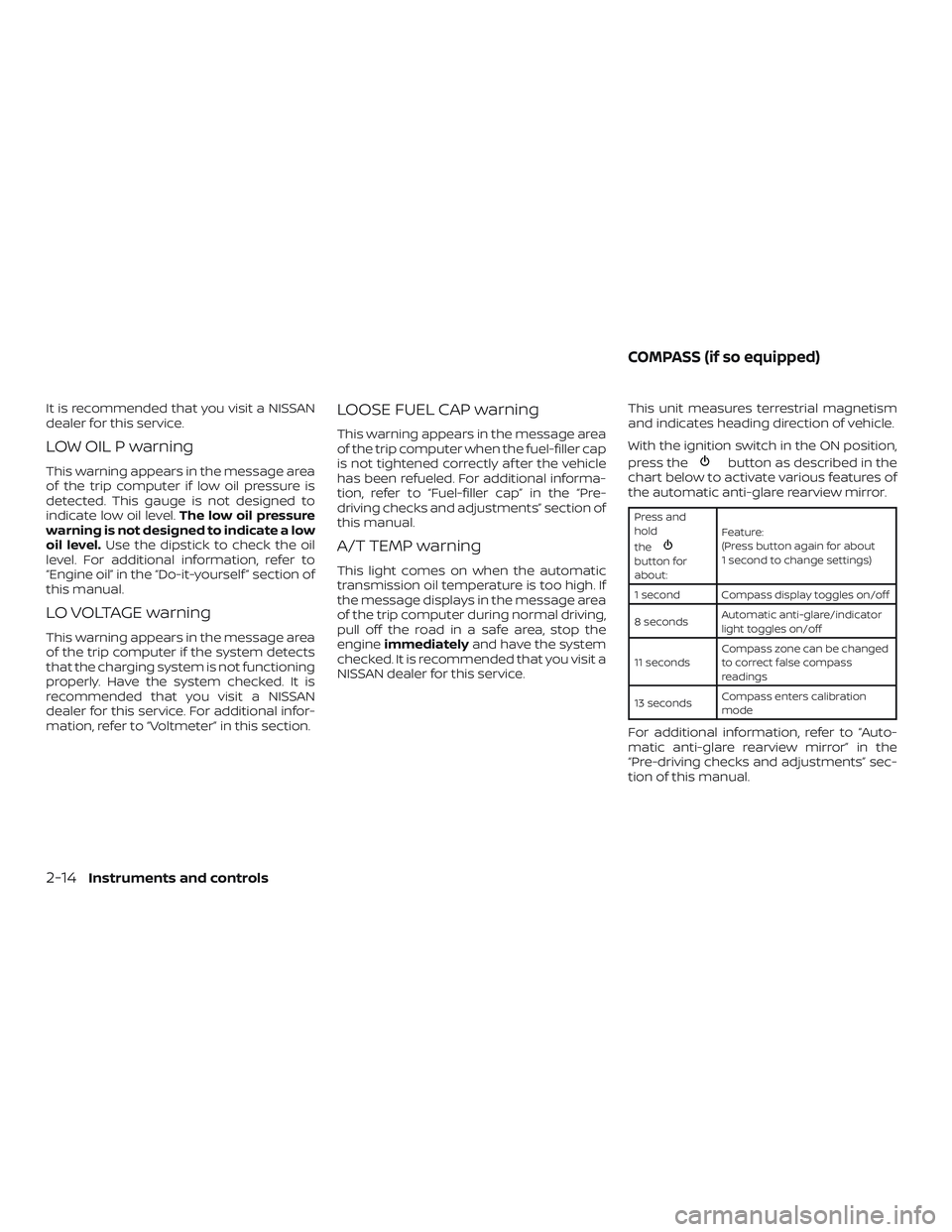
It is recommended that you visit a NISSAN
dealer for this service.
LOW OIL P warning
This warning appears in the message area
of the trip computer if low oil pressure is
detected. This gauge is not designed to
indicate low oil level.The low oil pressure
warning is not designed to indicate a low
oil level. Use the dipstick to check the oil
level. For additional information, refer to
“Engine oil” in the “Do-it-yourself ” section of
this manual.
LO VOLTAGE warning
This warning appears in the message area
of the trip computer if the system detects
that the charging system is not functioning
properly. Have the system checked. It is
recommended that you visit a NISSAN
dealer for this service. For additional infor-
mation, refer to “Voltmeter” in this section.
LOOSE FUEL CAP warning
This warning appears in the message area
of the trip computer when the fuel-filler cap
is not tightened correctly af ter the vehicle
has been refueled. For additional informa-
tion, refer to “Fuel-filler cap” in the “Pre-
driving checks and adjustments” section of
this manual.
A/T TEMP warning
This light comes on when the automatic
transmission oil temperature is too high. If
the message displays in the message area
of the trip computer during normal driving,
pull off the road in a safe area, stop the
engine immediately and have the system
checked. It is recommended that you visit a
NISSAN dealer for this service. This unit measures terrestrial magnetism
and indicates heading direction of vehicle.
With the ignition switch in the ON position,
press the
button as described in the
chart below to activate various features of
the automatic anti-glare rearview mirror.
Press and
hold
the
button for
about: Feature:
(Press button again for about
1 second to change settings)
1 second Compass display toggles on/off
8 seconds Automatic anti-glare/indicator
light toggles on/off
11 seconds Compass zone can be changed
to correct false compass
readings
13 seconds Compass enters calibration
mode
For additional information, refer to “Auto-
matic anti-glare rearview mirror” in the
“Pre-driving checks and adjustments” sec-
tion of this manual.
COMPASS (if so equipped)
2-14Instruments and controls
Page 107 of 426
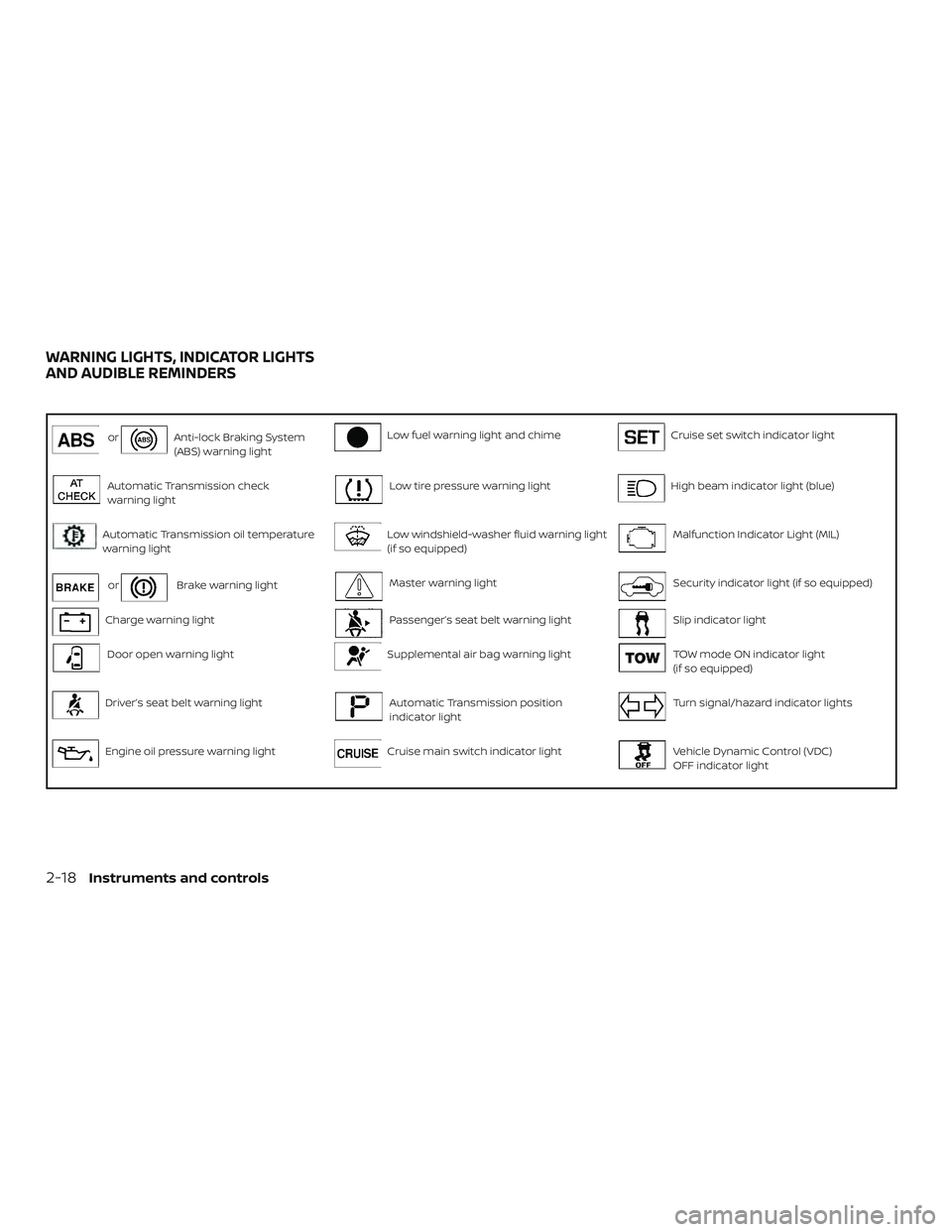
orAnti-lock Braking System
(ABS) warning lightLow fuel warning light and chimeCruise set switch indicator light
Automatic Transmission check
warning lightLow tire pressure warning lightHigh beam indicator light (blue)
Automatic Transmission oil temperature
warning lightLow windshield-washer fluid warning light
(if so equipped)Malfunction Indicator Light (MIL)
orBrake warning lightMaster warning lightSecurity indicator light (if so equipped)
Charge warning lightPassenger’s seat belt warning lightSlip indicator light
Door open warning lightSupplemental air bag warning lightTOW mode ON indicator light
(if so equipped)
Driver’s seat belt warning lightAutomatic Transmission position
indicator lightTurn signal/hazard indicator lights
Engine oil pressure warning lightCruise main switch indicator lightVehicle Dynamic Control (VDC)
OFF indicator light
WARNING LIGHTS, INDICATOR LIGHTS
AND AUDIBLE REMINDERS
2-18Instruments and controls
Page 108 of 426
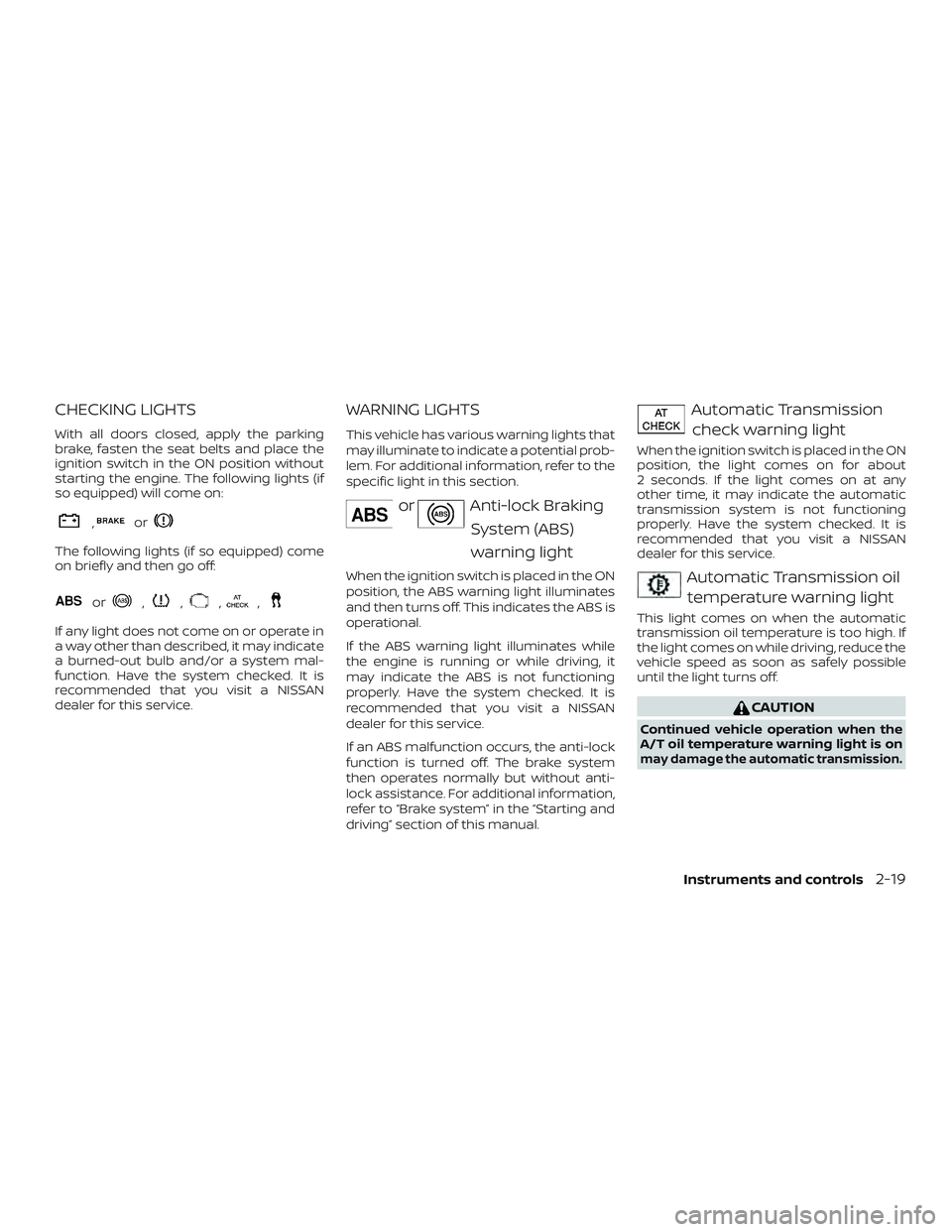
CHECKING LIGHTS
With all doors closed, apply the parking
brake, fasten the seat belts and place the
ignition switch in the ON position without
starting the engine. The following lights (if
so equipped) will come on:
,or
The following lights (if so equipped) come
on briefly and then go off:
or,,,,
If any light does not come on or operate in
a way other than described, it may indicate
a burned-out bulb and/or a system mal-
function. Have the system checked. It is
recommended that you visit a NISSAN
dealer for this service.
WARNING LIGHTS
This vehicle has various warning lights that
may illuminate to indicate a potential prob-
lem. For additional information, refer to the
specific light in this section.
orAnti-lock BrakingSystem (ABS)
warning light
When the ignition switch is placed in the ON
position, the ABS warning light illuminates
and then turns off. This indicates the ABS is
operational.
If the ABS warning light illuminates while
the engine is running or while driving, it
may indicate the ABS is not functioning
properly. Have the system checked. It is
recommended that you visit a NISSAN
dealer for this service.
If an ABS malfunction occurs, the anti-lock
function is turned off. The brake system
then operates normally but without anti-
lock assistance. For additional information,
refer to “Brake system” in the “Starting and
driving” section of this manual.
Automatic Transmissioncheck warning light
When the ignition switch is placed in the ON
position, the light comes on for about
2 seconds. If the light comes on at any
other time, it may indicate the automatic
transmission system is not functioning
properly. Have the system checked. It is
recommended that you visit a NISSAN
dealer for this service.
Automatic Transmission oiltemperature warning light
This light comes on when the automatic
transmission oil temperature is too high. If
the light comes on while driving, reduce the
vehicle speed as soon as safely possible
until the light turns off.
CAUTION
Continued vehicle operation when the
A/T oil temperature warning light is on
may damage the automatic transmission.
Instruments and controls2-19
Page 275 of 426
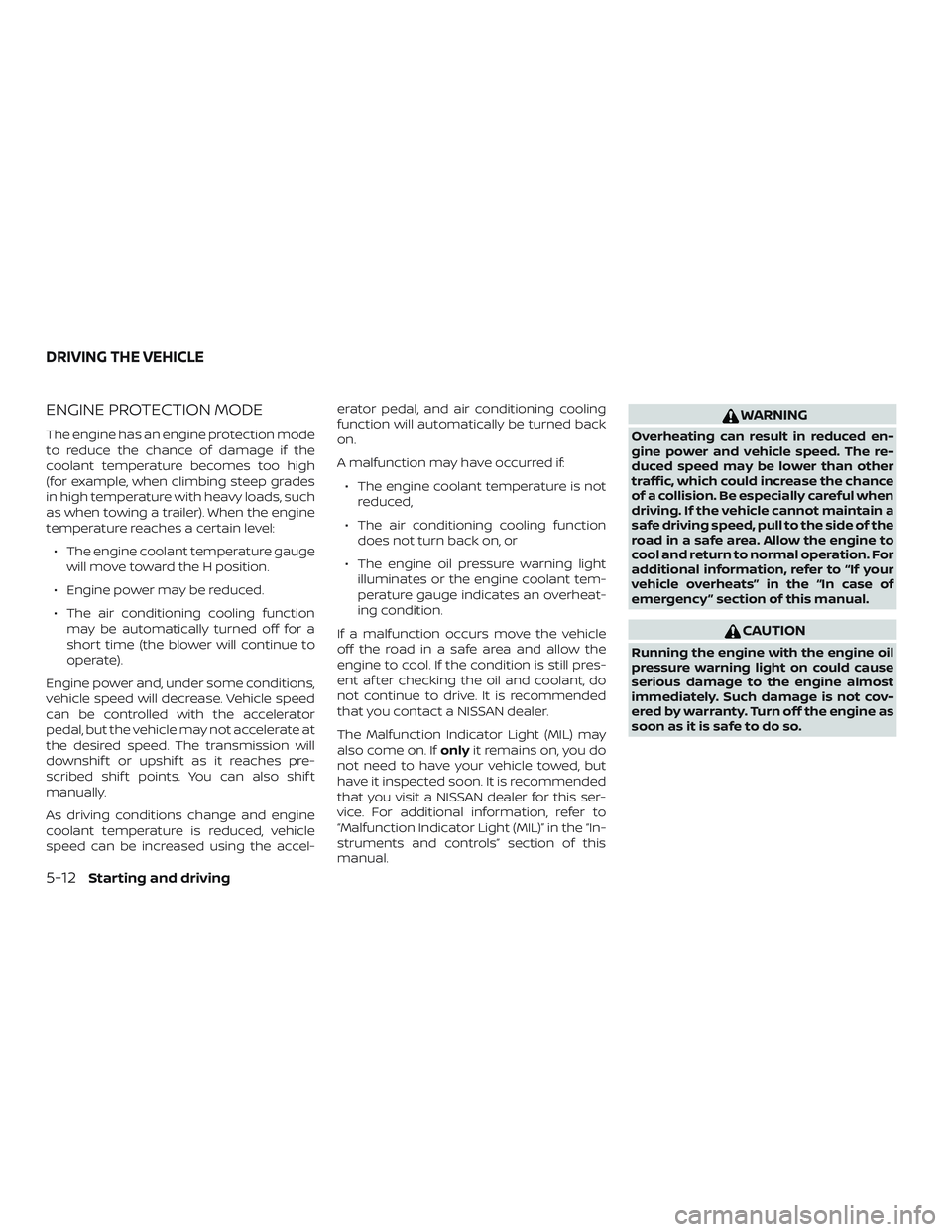
ENGINE PROTECTION MODE
The engine has an engine protection mode
to reduce the chance of damage if the
coolant temperature becomes too high
(for example, when climbing steep grades
in high temperature with heavy loads, such
as when towing a trailer). When the engine
temperature reaches a certain level:∙ The engine coolant temperature gauge will move toward the H position.
∙ Engine power may be reduced.
∙ The air conditioning cooling function may be automatically turned off for a
short time (the blower will continue to
operate).
Engine power and, under some conditions,
vehicle speed will decrease. Vehicle speed
can be controlled with the accelerator
pedal, but the vehicle may not accelerate at
the desired speed. The transmission will
downshif t or upshif t as it reaches pre-
scribed shif t points. You can also shif t
manually.
As driving conditions change and engine
coolant temperature is reduced, vehicle
speed can be increased using the accel- erator pedal, and air conditioning cooling
function will automatically be turned back
on.
A malfunction may have occurred if:
∙ The engine coolant temperature is not reduced,
∙ The air conditioning cooling function does not turn back on, or
∙ The engine oil pressure warning light illuminates or the engine coolant tem-
perature gauge indicates an overheat-
ing condition.
If a malfunction occurs move the vehicle
off the road in a safe area and allow the
engine to cool. If the condition is still pres-
ent af ter checking the oil and coolant, do
not continue to drive. It is recommended
that you contact a NISSAN dealer.
The Malfunction Indicator Light (MIL) may
also come on. If onlyit remains on, you do
not need to have your vehicle towed, but
have it inspected soon. It is recommended
that you visit a NISSAN dealer for this ser-
vice. For additional information, refer to
“Malfunction Indicator Light (MIL)” in the “In-
struments and controls” section of this
manual.
WARNING
Overheating can result in reduced en-
gine power and vehicle speed. The re-
duced speed may be lower than other
traffic, which could increase the chance
of a collision. Be especially careful when
driving. If the vehicle cannot maintain a
safe driving speed, pull to the side of the
road in a safe area. Allow the engine to
cool and return to normal operation. For
additional information, refer to “If your
vehicle overheats” in the “In case of
emergency ” section of this manual.
CAUTION
Running the engine with the engine oil
pressure warning light on could cause
serious damage to the engine almost
immediately. Such damage is not cov-
ered by warranty. Turn off the engine as
soon as it is safe to do so.
DRIVING THE VEHICLE
5-12Starting and driving
Page 285 of 426
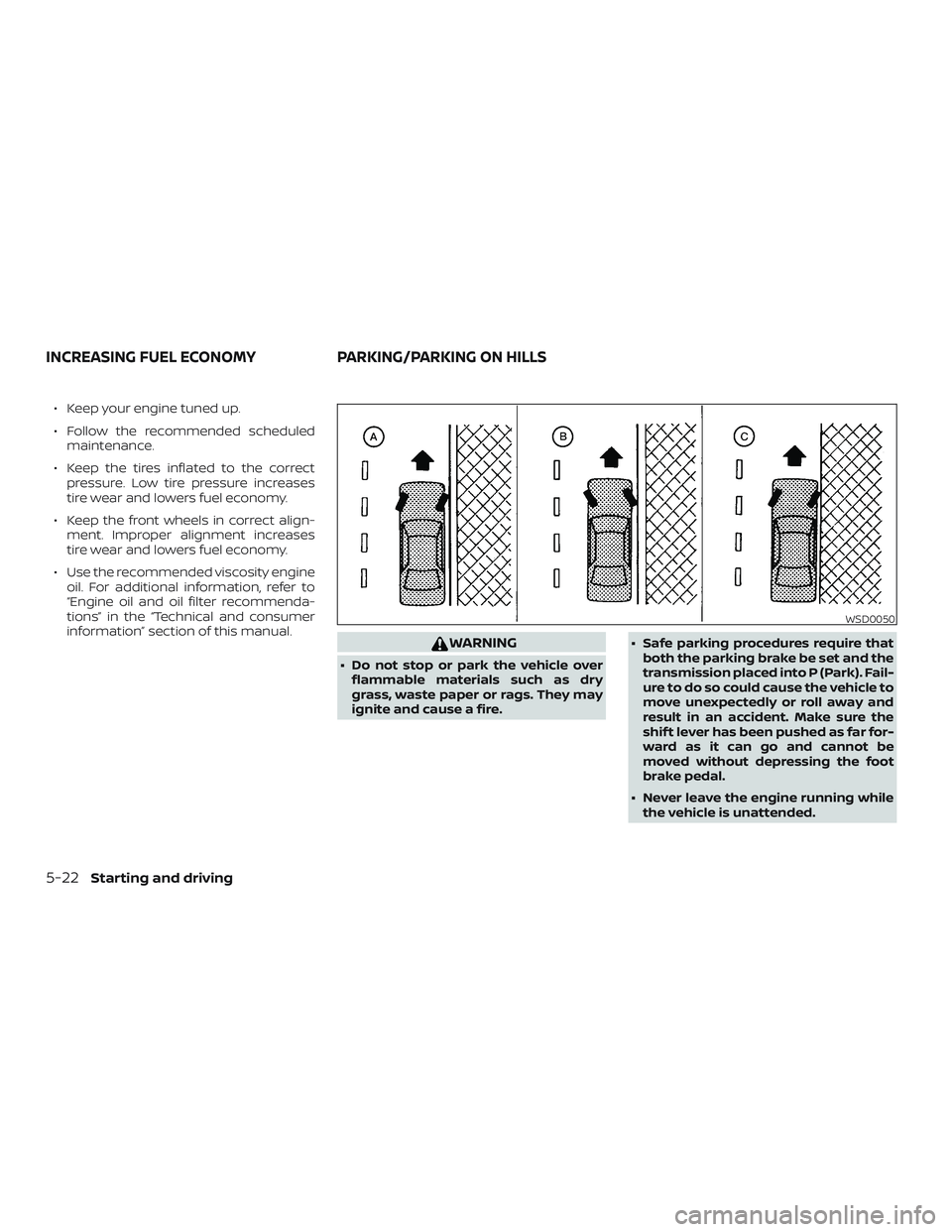
∙ Keep your engine tuned up.
∙ Follow the recommended scheduledmaintenance.
∙ Keep the tires inflated to the correct pressure. Low tire pressure increases
tire wear and lowers fuel economy.
∙ Keep the front wheels in correct align- ment. Improper alignment increases
tire wear and lowers fuel economy.
∙ Use the recommended viscosity engine oil. For additional information, refer to
“Engine oil and oil filter recommenda-
tions” in the “Technical and consumer
information” section of this manual.
WARNING
∙ Do not stop or park the vehicle overflammable materials such as dry
grass, waste paper or rags. They may
ignite and cause a fire. ∙ Safe parking procedures require that
both the parking brake be set and the
transmission placed into P (Park). Fail-
ure to do so could cause the vehicle to
move unexpectedly or roll away and
result in an accident. Make sure the
shif t lever has been pushed as far for-
ward as it can go and cannot be
moved without depressing the foot
brake pedal.
∙ Never leave the engine running while the vehicle is unattended.
WSD0050
INCREASING FUEL ECONOMY PARKING/PARKING ON HILLS
5-22Starting and driving
Page 322 of 426
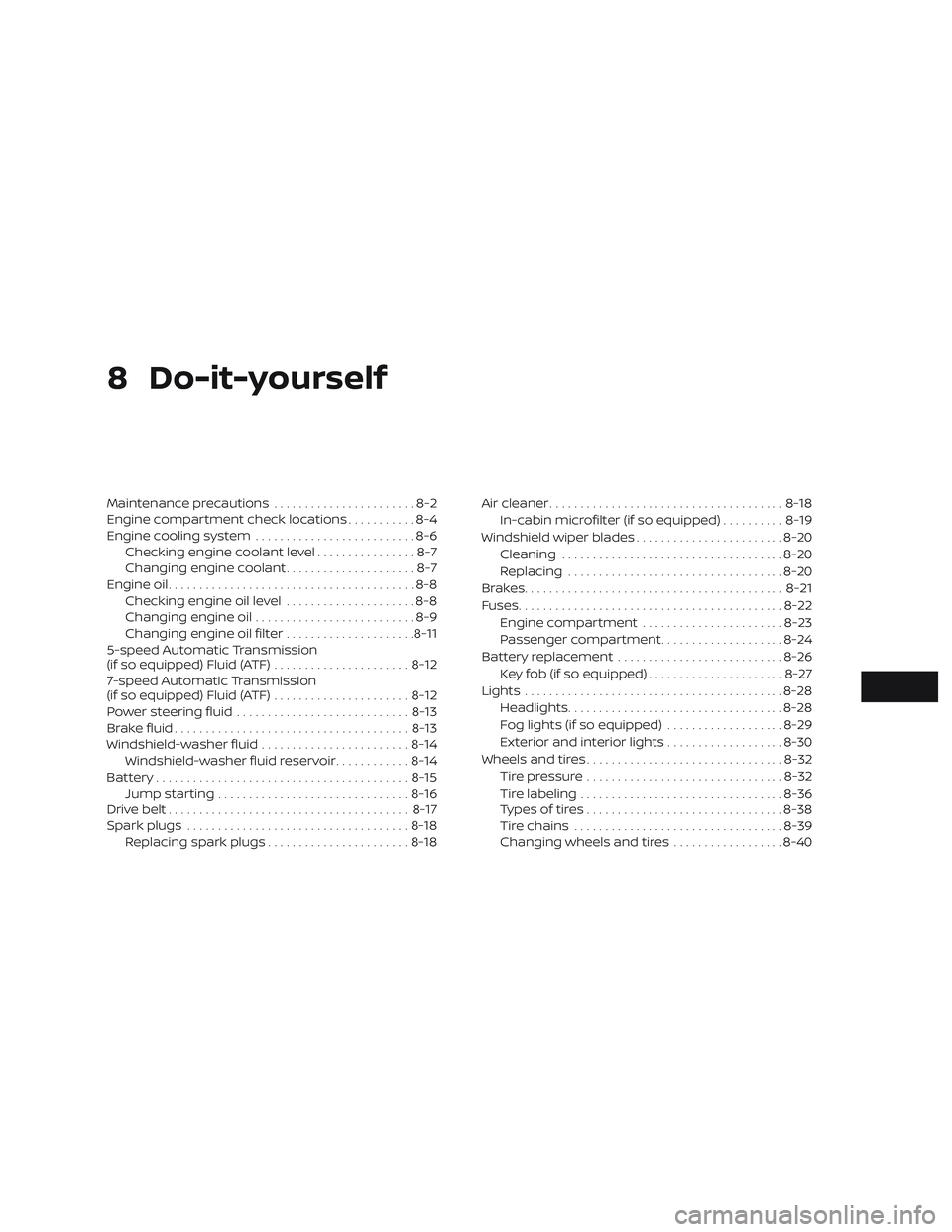
8 Do-it-yourself
Maintenance precautions.......................8-2
Engine compartment check locations ...........8-4
Engine cooling system ..........................8-6
Checking engine coolant level ................8-7
Changing engine coolant .....................8-7
Engine oil ........................................8-8
Checking engine oil level .....................8-8
Changing engine oil ..........................8-9
Changing engine oil filter .....................8-11
5-speed Automatic Transmission
(if so equipped) Fluid (ATF) ......................8-12
7-speed Automatic Transmission
(if so equipped) Fluid (ATF) ......................8-12
Power steering fluid ............................ 8-13
Brake fluid ...................................... 8-13
Windshield-washer fluid ........................8-14
Windshield-washer fluid reservoir ............8-14
Battery......................................... 8-15
Jump starting ............................... 8-16
Drive belt ....................................... 8-17
Spark plugs .................................... 8-18
Replacing spark plugs .......................8-18Air cleaner
...................................... 8-18
In-cabin microfilter (if so equipped) ..........8-19
Windshield wiper blades ........................8-20
Cleaning .................................... 8-20
Replacing ................................... 8-20
Brakes.......................................... 8-21
Fuses ........................................... 8-22
Engine compartment .......................8-23
Passenger compartment ....................8-24
Battery replacement ........................... 8-26
Key fob (if so equipped) ......................8-27
Lights .......................................... 8-28
Headlights ................................... 8-28
Fog lights (if so equipped) ...................8-29
Exterior and interior lights ...................8-30
Wheels and tires ................................ 8-32
Tire pressure ................................ 8-32
Tir
e labeling ................................. 8-36
Types of tires ................................ 8-38
Tire chains .................................. 8-39
Changing wheels and tires ..................8-40
Page 333 of 426
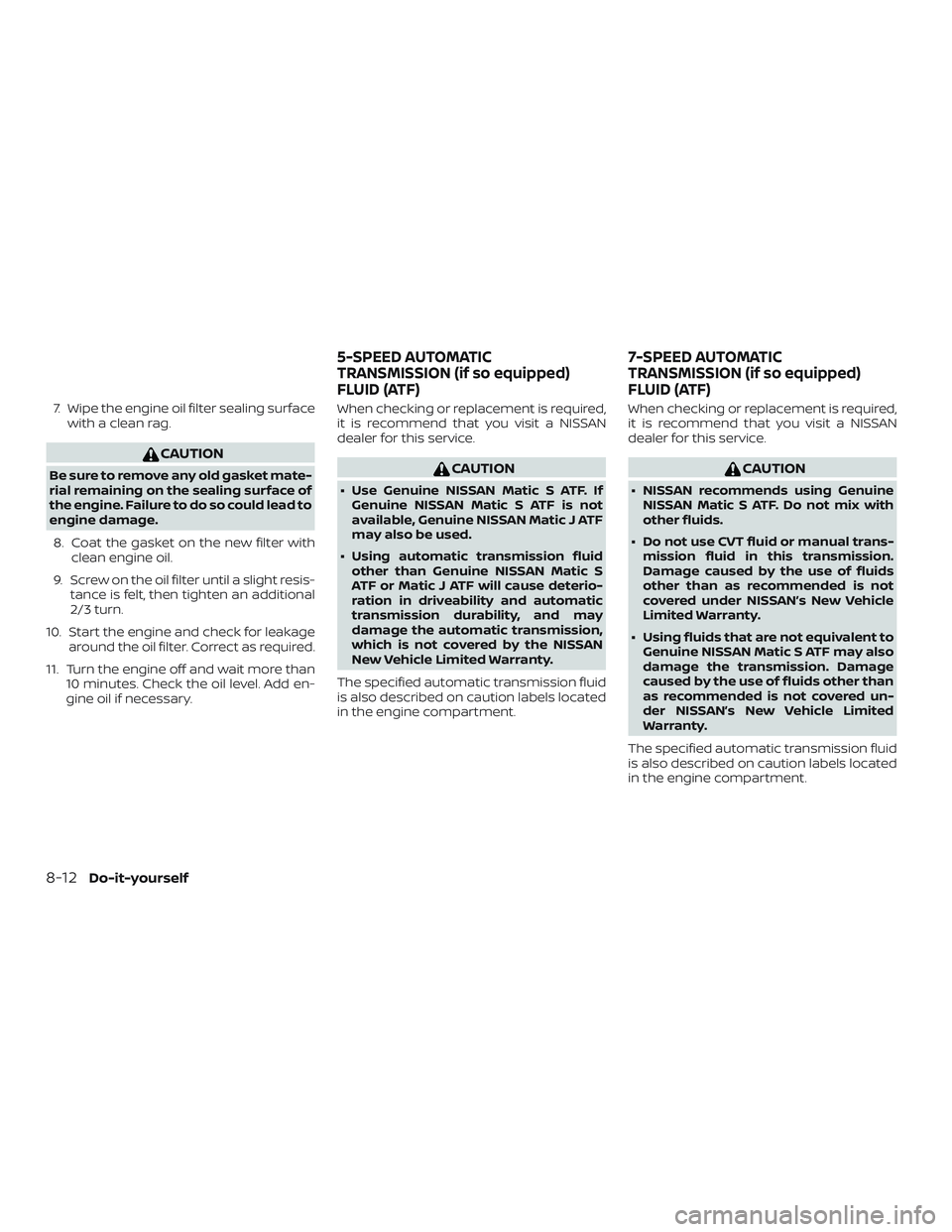
7. Wipe the engine oil filter sealing surfacewith a clean rag.
CAUTION
Be sure to remove any old gasket mate-
rial remaining on the sealing surface of
the engine. Failure to do so could lead to
engine damage.
8. Coat the gasket on the new filter with clean engine oil.
9. Screw on the oil filter until a slight resis- tance is felt, then tighten an additional
2/3 turn.
10. Start the engine and check for leakage around the oil filter. Correct as required.
11. Turn the engine off and wait more than 10 minutes. Check the oil level. Add en-
gine oil if necessary. When checking or replacement is required,
it is recommend that you visit a NISSAN
dealer for this service.CAUTION
∙ Use Genuine NISSAN Matic S ATF. If
Genuine NISSAN Matic S ATF is not
available, Genuine NISSAN Matic J ATF
may also be used.
∙ Using automatic transmission fluid other than Genuine NISSAN Matic S
ATF or Matic J ATF will cause deterio-
ration in driveability and automatic
transmission durability, and may
damage the automatic transmission,
which is not covered by the NISSAN
New Vehicle Limited Warranty.
The specified automatic transmission fluid
is also described on caution labels located
in the engine compartment. When checking or replacement is required,
it is recommend that you visit a NISSAN
dealer for this service.
CAUTION
∙ NISSAN recommends using Genuine
NISSAN Matic S ATF. Do not mix with
other fluids.
∙ Do not use CVT fluid or manual trans- mission fluid in this transmission.
Damage caused by the use of fluids
other than as recommended is not
covered under NISSAN’s New Vehicle
Limited Warranty.
∙ Using fluids that are not equivalent to Genuine NISSAN Matic S ATF may also
damage the transmission. Damage
caused by the use of fluids other than
as recommended is not covered un-
der NISSAN’s New Vehicle Limited
Warranty.
The specified automatic transmission fluid
is also described on caution labels located
in the engine compartment.
5-SPEED AUTOMATIC
TRANSMISSION (if so equipped)
FLUID (ATF) 7-SPEED AUTOMATIC
TRANSMISSION (if so equipped)
FLUID (ATF)
8-12Do-it-yourself
Page 371 of 426
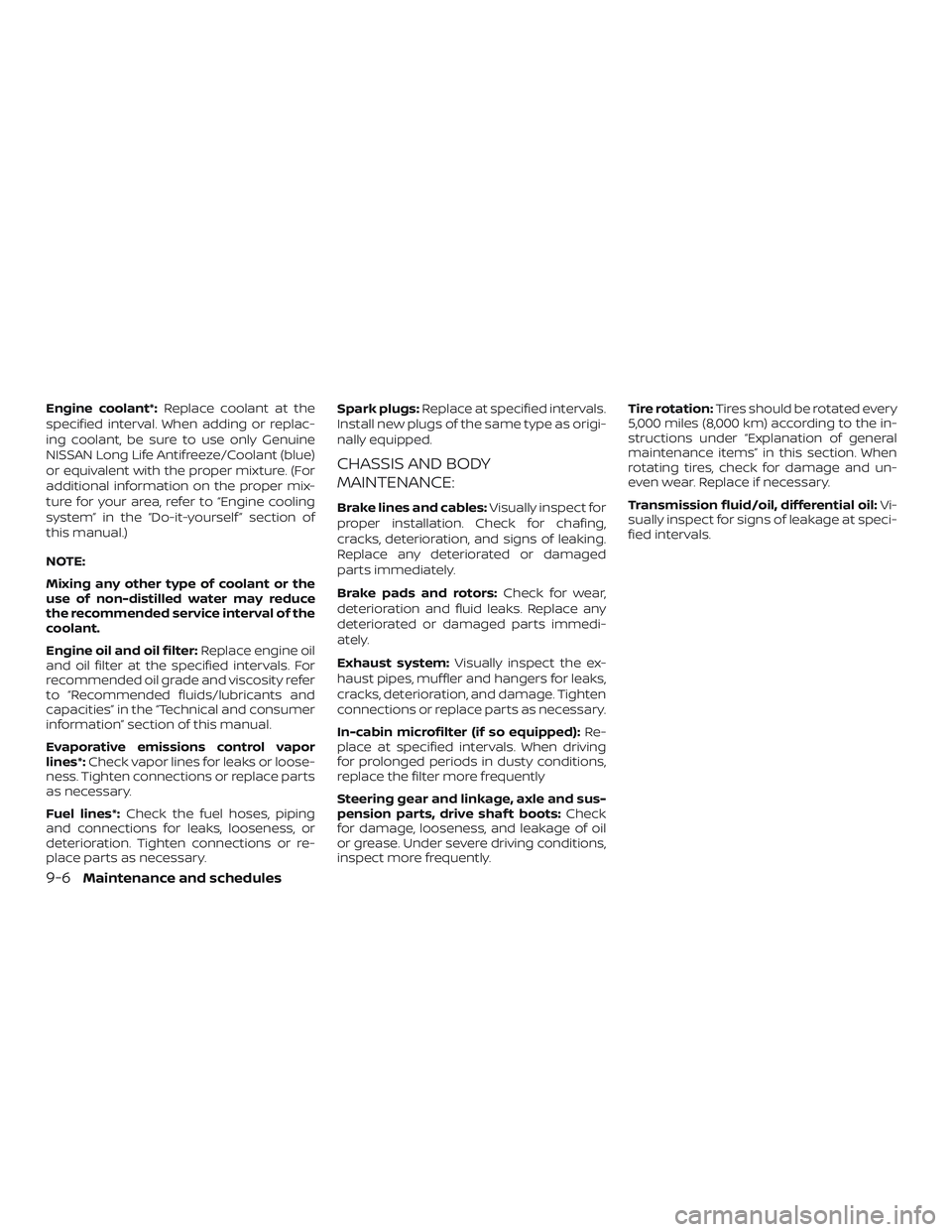
Engine coolant*:Replace coolant at the
specified interval. When adding or replac-
ing coolant, be sure to use only Genuine
NISSAN Long Life Antifreeze/Coolant (blue)
or equivalent with the proper mixture. (For
additional information on the proper mix-
ture for your area, refer to “Engine cooling
system” in the “Do-it-yourself ” section of
this manual.)
NOTE:
Mixing any other type of coolant or the
use of non-distilled water may reduce
the recommended service interval of the
coolant.
Engine oil and oil filter: Replace engine oil
and oil filter at the specified intervals. For
recommended oil grade and viscosity refer
to “Recommended fluids/lubricants and
capacities” in the “Technical and consumer
information” section of this manual.
Evaporative emissions control vapor
lines*: Check vapor lines for leaks or loose-
ness. Tighten connections or replace parts
as necessary.
Fuel lines*: Check the fuel hoses, piping
and connections for leaks, looseness, or
deterioration. Tighten connections or re-
place parts as necessary. Spark plugs:
Replace at specified intervals.
Install new plugs of the same type as origi-
nally equipped.
CHASSIS AND BODY
MAINTENANCE:
Brake lines and cables: Visually inspect for
proper installation. Check for chafing,
cracks, deterioration, and signs of leaking.
Replace any deteriorated or damaged
parts immediately.
Brake pads and rotors: Check for wear,
deterioration and fluid leaks. Replace any
deteriorated or damaged parts immedi-
ately.
Exhaust system: Visually inspect the ex-
haust pipes, muffler and hangers for leaks,
cracks, deterioration, and damage. Tighten
connections or replace parts as necessary.
In-cabin microfilter (if so equipped): Re-
place at specified intervals. When driving
for prolonged periods in dusty conditions,
replace the filter more frequently
Steering gear and linkage, axle and sus-
pension parts, drive shaf t boots: Check
for damage, looseness, and leakage of oil
or grease. Under severe driving conditions,
inspect more frequently. Tire rotation:
Tires should be rotated every
5,000 miles (8,000 km) according to the in-
structions under “Explanation of general
maintenance items” in this section. When
rotating tires, check for damage and un-
even wear. Replace if necessary.
Transmission fluid/oil, differential oil: Vi-
sually inspect for signs of leakage at speci-
fied intervals.
9-6Maintenance and schedules